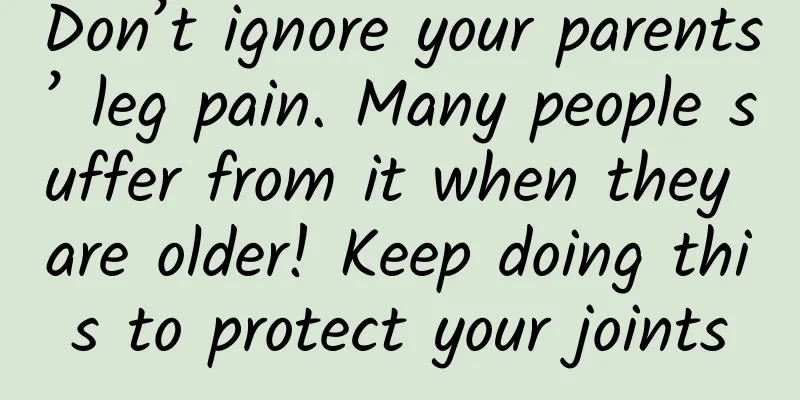Don’t ignore your parents’ leg pain. Many people suffer from it when they are older! Keep doing this to protect your joints

|
My parents are getting old, climbing the stairs Why do my knee joints make crackling sounds, feel sore and painful? When you wake up in the morning, do you feel that your legs cannot be straightened and are stiff? This may be primary osteoarthritis A disease that is more common among middle-aged and elderly people Our joints are like parts of a machine. Usually you need to take good care of it Today, Dr. Huaxi will teach you How to reduce or delay the onset of osteoarthritis Share this with your parents now! Osteoarthritis is a degenerative disease that generally occurs in middle-aged and elderly people. The incidence rate increases with age. Image source: Photo Network In my country, the prevalence of primary osteoarthritis in people aged 40-49 and 50-59 is 30.1% and 48.7% respectively, and the prevalence in people over 60 years old exceeds 62%! Friends over 40 should pay more attention and be careful that osteoarthritis may sneak up on them inadvertently. Osteoarthritis can affect any joint, including the muscles and tissues around the joints. You may experience: 1. Pain: including joint pain and local tenderness of joints. In the early stage, it manifests as mild or moderate dull pain, which is relieved after rest and aggravated after activity; in the middle stage, the pain lasts longer and may affect daily activities; in the late stage, there may be persistent dull pain/dull pain accompanied by intermittent severe pain. In addition, pain is often related to weather changes, and the pain may be aggravated in cold and humid weather. 2. Morning stiffness: When you wake up in the morning, you feel stiffness in your joints, as if they were frozen. This stiffness usually lasts no more than 30 minutes and can be relieved by a little movement. 3. Swelling: Swelling of joints, such as swollen knees. 4. Clicking sound during joint movement: It is more common in the knee joint. Due to cartilage destruction and uneven joint surface, a "clicking" sound may be heard when moving the knee joint. 5. Instability: Patients with knee osteoarthritis may experience "weak legs" when walking. 6. Limited mobility: reduced joint mobility, such as knee flexion/extension not reaching normal levels. 7. Joint deformity: Patients with late-stage joint injuries may experience joint deformity. For example, patients with knee osteoarthritis may develop "bow legs" in the late stage, and patients with finger arthritis may experience swollen finger joints. If you have similar symptoms, you can go to the hospital to take an X-ray of the corresponding part and find a professional doctor for diagnosis and treatment. Our bones and joints are like machine parts. They need to be well maintained on a regular basis. If problems arise and we wait for repairs, it will more or less have some impact on our lives. There is currently no drug that can stop or reverse the progression of osteoarthritis, but clinical practice has shown that proper prevention can effectively reduce or delay the occurrence of osteoarthritis. Image source: Photo Network In daily life, the following aspects should be paid attention to in order to prevent osteoarthritis, especially for the middle-aged and elderly people: 1 Weight control Obesity is an important cause of osteoarthritis. When BMI>24, it is considered overweight. When BMI>28, the BMI size is directly proportional to the probability of knee osteoarthritis. (BMI=weight (kg)/height (m) squared) Therefore, it is recommended that once you exceed the standard weight, you should lose weight appropriately. However, when losing weight, you should avoid excessive and inappropriate exercise on the one hand, and ensure nutritional intake on the other hand. 2 Avoid standing, walking, or squatting for long periods of time Standing, walking, or squatting for long periods of time will increase the burden on the joints and accelerate joint degeneration. Image source: Photo Network If you have to stand or walk for a long time, you can use crutches to reduce the burden on your joints. At the same time, try to avoid climbing stairs, slopes, mountains, etc. for long periods of time, avoid sitting on low benches for long periods of time, and avoid squatting for too long. 3 Keep exercising properly Exercise can strengthen the supporting function of muscles, tendons and ligaments around joints, help relieve pain, improve function and protect joints, and prevent and alleviate the occurrence and development of osteoarthritis. It should be noted that you should try not to do exercises that increase the load on your joints, such as squats. When pain, stiffness, or swelling occur in your joints, you should reduce the amount of exercise or stop exercising. For patients with osteoarthritis, it is necessary to avoid strenuous exercise and excessive exercise. Some low-impact aerobic exercises such as walking, swimming and cycling can be performed . These exercises do not put too much burden on the knee joints and can also allow the muscles to fully move. Image source: Photo Network In addition, you can also do some targeted training to strengthen the muscles around the joints, such as: sit on a stool, straighten your legs, then lift them up and hold for 30 seconds, and repeat. Image source: taken by myself 4 Timely treatment of trauma Knee trauma may directly damage the knee cartilage or affect the stability of the knee joint. Therefore, if acute trauma occurs during exercise, travel, etc., you must go to the hospital for treatment in time to avoid leaving sequelae. 5 Keep your joints warm Being exposed to the wind or in a cold environment may aggravate the symptoms of knee discomfort. Therefore, we should pay attention to keeping warm in our daily life. Statement: This article is a medical-related educational popular science article. It does not involve specific treatment methods or medical behaviors and cannot replace hospital visits. Experts who reviewed this article References [1]Xue Qingyun, Wang Kunzheng, Pei Fuxing, et al. Survey on the prevalence of primary osteoarthritis in Chinese people aged 40 years and above[J]. Chinese Journal of Orthopaedics, 2015, 35(12):1206-1212.DOI:10.3760/cma.j.issn.0253-2352.2015.12.005. [2] Joint Surgery Group of the Orthopaedic Branch of the Chinese Medical Association, Osteoarthritis Group of the Orthopaedic Branch of the Chinese Medical Doctor Association, National Clinical Research Center for Geriatric Diseases (Xiangya Hospital), et al. Guidelines for the diagnosis and treatment of osteoarthritis in China (2021 edition) [J]. Chinese Journal of Orthopaedics, 2021, 41(18):24. DOI:10.3760/cma.j.cn121113-20210624-00424. Content Production Edit: 100% sweet Map: Eastern Zhou Dynasty |
<<: Is your phone charger still plugged into the socket? Unplug it now!
>>: Supercritical steam? Hidden fourth star? Kepler telescope discovers extrasolar water world
Recommend
Brand community SOP writing and practice
In the process of community operation , some bran...
5 "pitfalls" to avoid in marketing activities
As the old saying goes, "Failure is the moth...
Brand Marketing Promotion | How to build a brand communication system?
Introduction: If a brand is a living organism and...
Phoenix.com announces massive layoffs; established portals are transforming
[[147697]] Following the massive layoffs at Sina ...
With no money and no resources, how did Keep gain 60 million users through “dirty work”?
As a post-90s campus entrepreneur with no resourc...
Perfection: My Oculus Rift Consumer Edition Experience Report
Recently, I was lucky enough to get a chance to e...
Sony selflessly contributes LDAC: Android O wireless sound quality explodes
Earlier, there were rumors that Google's next-...
One trick cost 150,000 yuan in advertising fees! Do you still dare to use these information flow copywriting?
In the past week, nine home improvement companies...
AI can beat various world champions, but becomes an "amateur" when playing cards!
In 1994, an AI called Chinook defeated humans in ...
This tree has a "ghost face", but it is loved by people...
Many people shudder when seeing the word "gh...
Facebook Ads Policy Tips!
1. Finance Can real money appear in loan app mate...
5 kinds of "aging agents" are hidden in our daily food, try to avoid them as much as possible!
Everyone wants to age more slowly, but in life, s...
Cyanogen and Microsoft reach strategic partnership to bundle Microsoft apps
Rumors of a partnership between Microsoft and Cya...
The days of HTC's 21-year-old life are numbered
"Far and away from faith." Recently, a ...
iOS Statistics
[[148848]] Statistics management is a very import...









